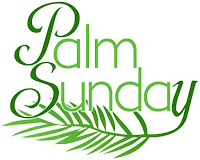The date for the week is established based on the date of Easter, which is determined by a combination of the season and the status of the moon. The council of Nicea declared Easter Sunday to be the first Sunday after the first full moon on or after the vernal equinox (aka first day of spring.) That is still how the date is determined among non-Orthodox Christian churches.
Palm Sunday (or Passion Sunday)
 |
| Source |
Palm Sunday is the last Sunday before Easter, and kicks off Holy Week. The church services that day read the story of Jesus coming into Jerusalem that's recorded in Matthew 21, Mark 11, Luke 19, and John 12. During services, parishioners are given palm branches to wave.
The history of celebrating the day is uncertain, but there are records of the day being celebrated as early as the 4th century in Jerusalem, and the 9th century elsewhere.
Maundy Thursday (or Holy Thursday)
 |
| Source |
Maundy Thursday is the Thursday before Easter. Out of the days of Holy Week covered here, Maundy Thursday is the one that is mostly likely to not be understood by the average Christian.
Maundy Thursday is believed to be the day Jesus Christ celebrated his last Passover. (My post on Passover will go up later this week.) According the the Biblical story, his last Passover is when Jesus washed the feet of his disciples (an act of humility), commanded his disciples to do the same with each other, and commanded his disciples to love each other.
Good Friday
 |
| Source |
Good Friday is the Friday before Easter and the day Christians believe Jesus was hung on the cross until dead.
In church services held on Good Friday, it's traditional to not serve communion as it's a day of sorrow and communion is seen as a celebration. It's also traditional to remove ornamentation on the altar and cover both the altar and the cross in black to signify death.
It's also not uncommon for some churches to have Stations of the Cross during their service, where each station symbolizes a part of the arrest, trial, and crucifixion in the story of his death.
It's also not uncommon for some churches to have Stations of the Cross during their service, where each station symbolizes a part of the arrest, trial, and crucifixion in the story of his death.
Easter Sunday
 |
| Source |
To Christians, Easter Sunday is believed to be the day that Jesus rose from the dead, making it a day of great joy for Christians.
In many churches, it's customary to have what is called a "sunrise service" in the early morning (ex. 6 am). For churches that have that and the Good Friday service mentioned above, this service starts off dark, then the black covering the altar and cross are removed and the ornamentations replaced. Simultaneously, the lights in the sanctuary (or nave) are brightened to symbolize Jesus rising from the dead.
There are many ways to celebrate the day. One common way Christians celebrate is to get together with their family and enjoy a meal together. Lamb is common as the meat for the meal because Christians see Jesus as the "lamb of God." However, ham is traditional in my family, and I'm sure many others.
Sources
- ThoughtCo pages on Palm Sunday,
- Christianity.com page on Maundy Thursday
- Christian Research Institute's pages on the week and the Easter Vigil
No comments:
Post a Comment